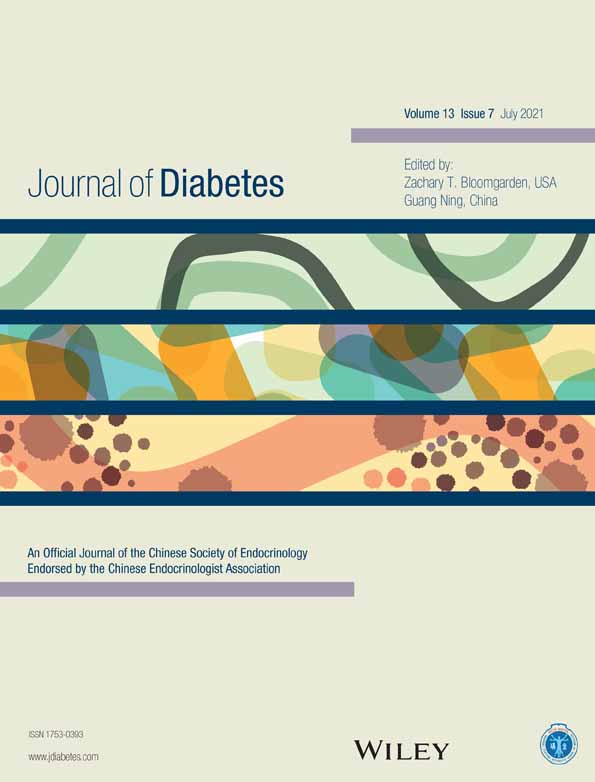Developments in type 1 and type 2 diabetes
1型和2型糖尿病的研究进展
A reminder of the overlap of type 1 diabetes (T1D) with features of T2D is the current report of a 25% prevalence of metabolic syndrome among persons with T1D.1 Perhaps in part related to the high prevalence of insulin resistance in T1D and its association with rapid heart rate, the Diabetes Control and Complications Trial/Epidemiology of Diabetes Interventions and Complications follow-up analysis showed a significant association between heart rate and cardiovascular disease (CVD); also of note in this study is the lower heart rate among those initially randomized to intensive glycemic control, suggesting that heart rate also reflect autonomic neuropathy as a complication of hyperglycemia.2 A non-insulin liver-selective glucokinase activator was reported as benefiting T1D, with TTP399 found in a small study to show modest benefit in reducing glycosylated hemoglobin (HbA1c) levels, along with an improvement in continuous glucose monitoring (CGM)-measured “time in range” during daytime hours, both of intrinsic importance and showing the potential of CGM as an alternative to HbA1c in ascertainment of glycemic benefit of new pharmacologic approaches.3
Turning to T2D, a multicountry data analysis including approximately 22 million diabetes diagnoses from 5 billion person-years of follow-up over the past two and a half decades showed that the incidence of T2D had increased from 1995 to around 2010, but over the subsequent decade declined in high- and middle-income countries.4 Although this is reassuring, given the relationship of diabetes to obesity, we may see growth of T2D anew over coming years. In an analysis based on the Multi-Ethnic Study of Atherosclerosis (MESA), the population fraction of diabetes in the US attributable to obesity increased over the one and a half decades ending 2016 from 35% to 41%, particularly among women.5 A 30-year follow-up report of the Da Qing study of prediabetes showed that participants regressing to normal glucose tolerance had lesser likelihood of development of CVD and microvascular disease than those who progressed to diabetes.6 The adverse effect of development of diabetes over the past three decades in the US National Health and Nutrition Examination Survey (NHANES) is shown in a report of nearly 1500 persons who had developed diabetes within 2 years; although the prevalence of clinical albuminuria decreased from 39% to 19% from 1988 to 2018, there was little change in the prevalence of low glomerular filtration rate, retinopathy, or CVD.7 Even more strikingly, a 40-year follow-up of nearly 3000 persons having glucose tolerance testing around 1980 showed that those with prediabetes and diabetes at baseline had 4.3 and 7.9 years of potential life lost (YPLL), respectively, compared with those with normoglycemia, with women having greater YPLL.8
Given the particular importance of CVD in diabetes, a meta-analysis of differences between outcomes among trial participants from Asian vs White populations in CV benefits of sodium glucose cotransporter 2 inhibitors (SGLT2i) and glucagon-like peptide 1 receptor agonists (GLP-1RA) found significantly greater reduction in CV death or hospitalization for heart failure among Asians with heart failure and reduced ejection fraction with SGLT2i, and significantly greater reduction in major adverse cardiovascular events (MACE) among Asians with diabetes and underlying CVD.9 Inasmuch as half or more of the global population with diabetes is Asian,10 greater availability of these agents must be considered a global priority. A “real-world” propensity score-matched cohort analysis of addition of either an SGLT2i or sulfonylurea to GLP-1RA showed 24% reduction in CV endpoints and 32% reduction in all-cause mortality with the former,11 leading a commentator to opine, “All practitioners involved in the care of people living with T2D need to heed these data as a call to action.12” Importantly, the oft-made suggestion that such treatment is particularly important among younger persons appears incorrect based on meta-analyses of MACE outcomes among persons less than vs greater than or equal to age 75 treated with GLP-1RA, and heart failure hospitalization outcomes among persons less than vs greater than or equal to age 65 treated with SGLT2i; it appears that the older group has greater benefit.13
需要提醒的是,1型糖尿病(T1D)与2型糖尿病(T2D)特征重叠,目前的报告显示T1D患者中代谢综合征的患病率为25%。糖尿病控制和并发症试验/糖尿病干预流行病学和并发症随访分析显示,心率和心血管疾病(CVD)之间存在显著的相关性,也许部分原因与T1D中胰岛素抵抗的高患病率及其与快速心率的关系有关;在这项研究中,同样值得注意的是,在最初随机接受强化血糖控制的患者中,心率较低,这表明心率也反映出自主神经病变是高血糖的并发症。据报道,一种非胰岛素的肝脏选择性葡糖激酶激活剂TTP399对T1D有利,在一项小型研究中发现,该药在降低糖化血红蛋白(HbA1c)水平方面略有益处,同时改善了连续血糖监测(CGM)测量的“范围内时间”,这两项研究都具有内在重要性,表明CGM在确定新的药理学方法降血糖益处中可替代HbA1c。
关于T2D,一项多国数据分析中华包括过去25年50亿人年随访中的大约2200万例糖尿病诊断,显示T2D的发病率从1995年到2010年左右有所上升,但在随后的十年中,高收入和中等收入国家的发病率有所下降。尽管这令人安心,但考虑到糖尿病与肥胖的关系,我们可能会看到T2D在未来几年再次增长。在一项基于动脉粥样硬化多种族研究(MESA)的分析中,截至2016年的15年里,美国可归因于肥胖的糖尿病人口比例从35%上升到41%,特别是在女性中。“大庆”糖尿病前期研究的30年随访报告显示,与进展为糖尿病的参与者相比,恢复到正常糖耐量的参与者患心血管疾病和微血管疾病的可能性较小。美国国家健康和营养检查调查(NHANES)对近1500名在2年内发展为糖尿病的患者的报告指出了过去30年糖尿病发展的不利因素;虽然从1988年到2018年,临床蛋白尿的患病率从39%下降到19%,但低肾小球滤过率、视网膜病变或心血管疾病的患病率几乎没有变化。更值得注意的是,对近3000名在1980年左右接受葡萄糖耐量试验的受试者进行了长达40年的随访,结果显示,与血糖正常的女性相比,糖尿病前期患者和基线糖尿病患者的潜在寿命分别减少了4.3年和7.9年,女性的潜在寿命损失更多。
考虑到心血管疾病在糖尿病中的特殊重要性,meta分析了来自亚洲人群和白种人人群的试验参与者在钠葡萄糖协同转运体2抑制剂(SGLT2i)和胰高血糖素样肽1受体激动剂(GLP-1RA)的心血管益处方面的结果差异,发现在患有心力衰竭和服用SGLT2i的亚洲人中,心血管死亡或因心力衰竭住院的人数显著减少,在患有糖尿病和潜在心血管疾病的亚洲人中,主要不良心血管事件(MACE)的发生率显著降低。因为全球糖尿病患者中有一半或更多是亚洲人,必须将提高这些药物的可用性视为全球优先事项。在GLP-1RA中加入SGLT2i或磺脲类药物的“真实世界”倾向得分匹配的队列分析显示,前者的心血管终点降低了24%,全因死亡率降低了32%。一位评论员认为:“所有参与治疗T2D患者的从业者都需要注意这些数据,以此作为行动的号召。重要的是,经常提出的这种治疗在年轻人中似乎是不正确的,这是基于对接受GLP-1RA治疗的年龄小于75岁和大于或等于75岁人的MACE结果,以及使用SGLT2i治疗年龄小于65岁和大于或等于65岁人的心力衰竭住院结果进行的meta分析;也许老年组有更大的好处。




